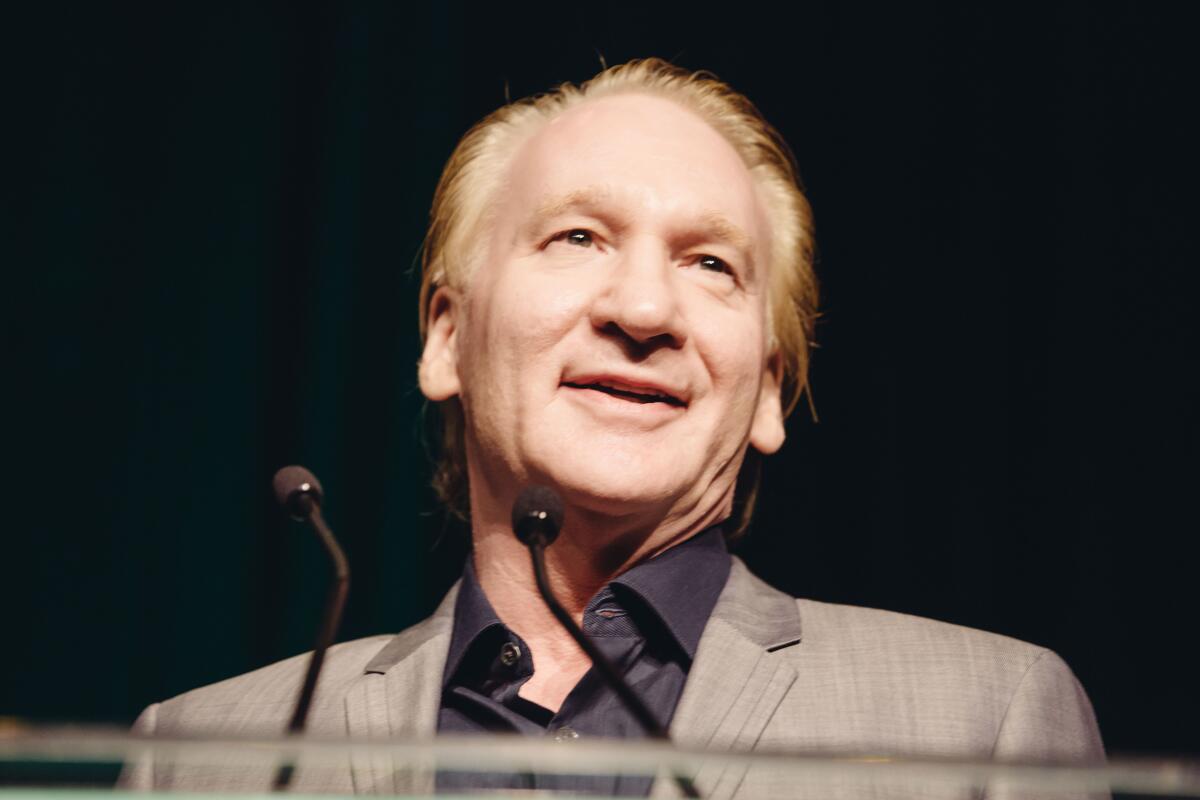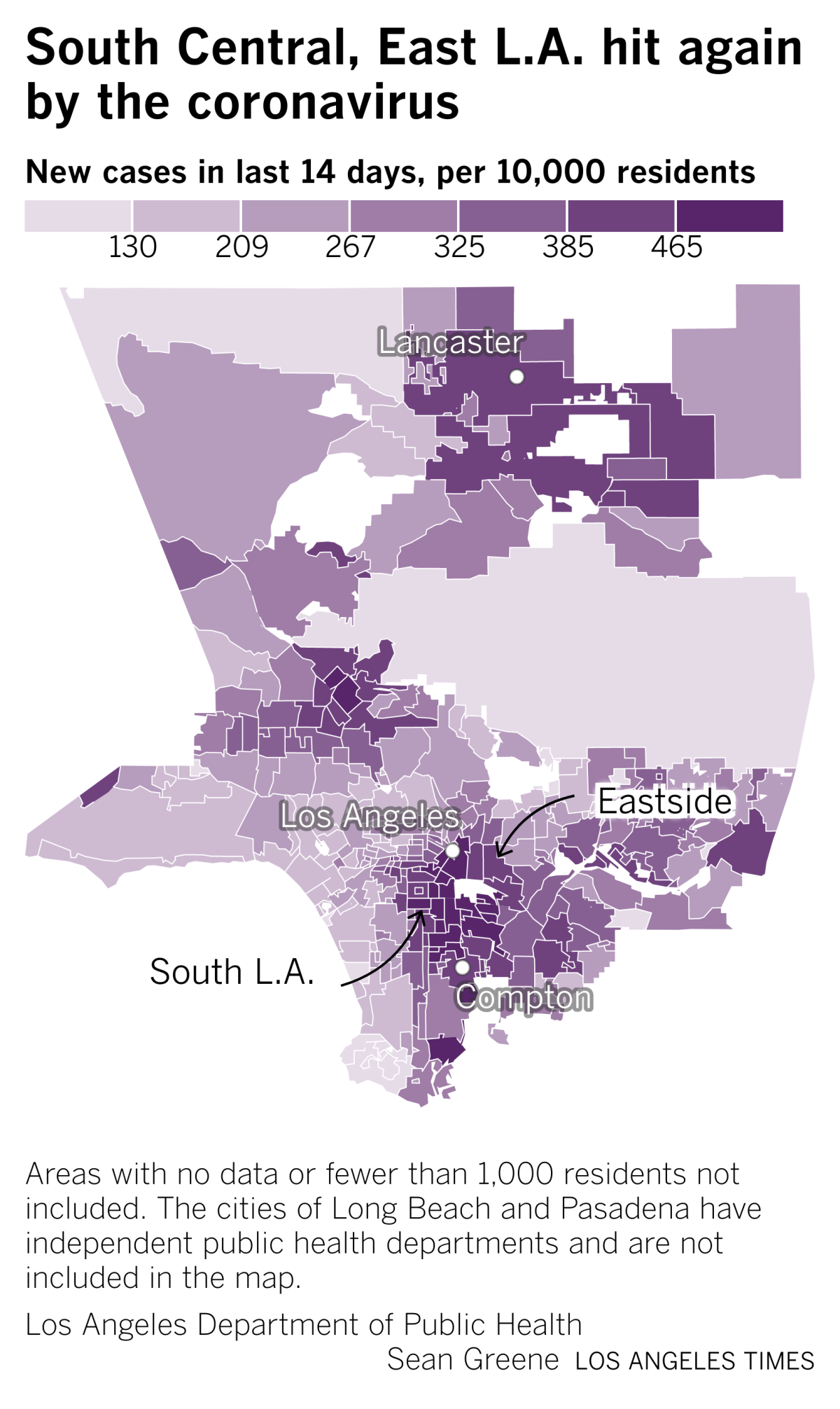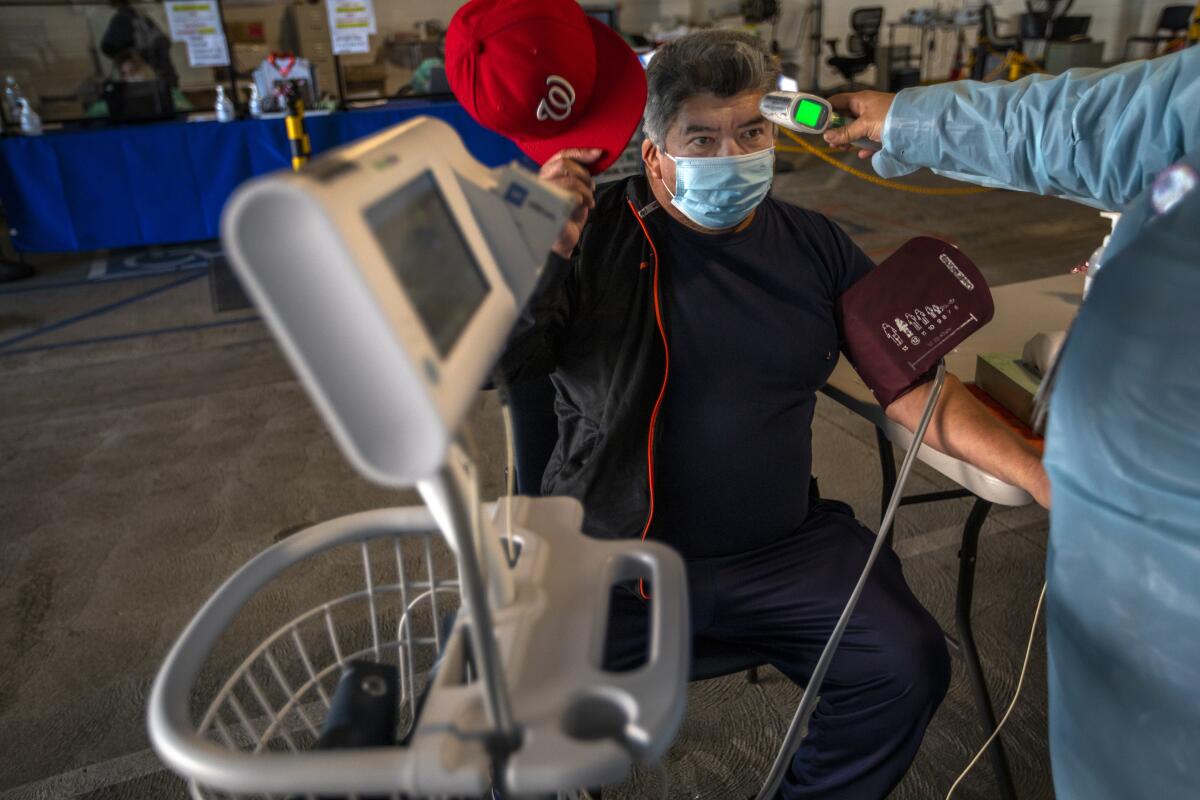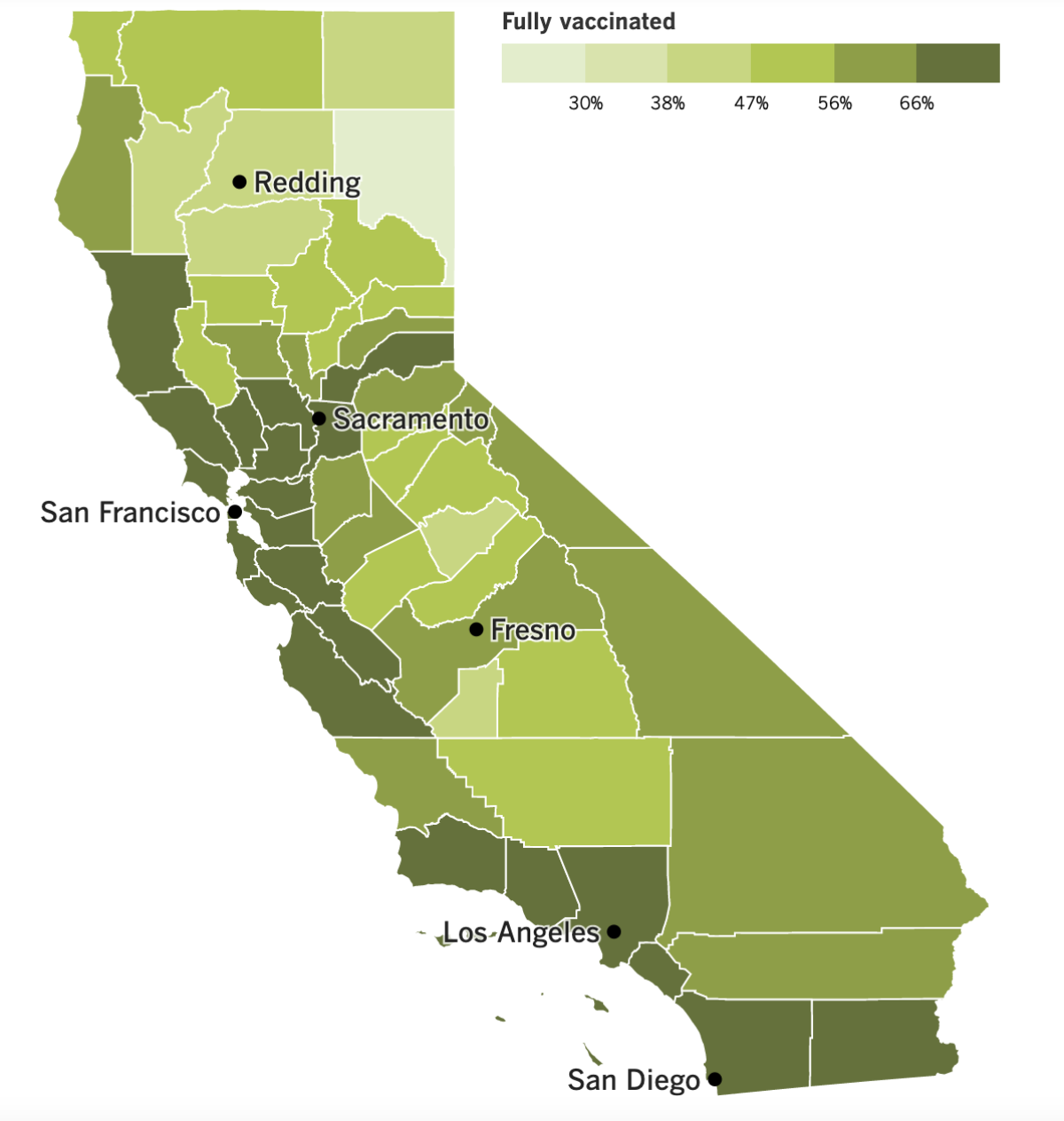Coronavirus Today: Are we really ‘done with COVID’?
- Share via
Good evening. I’m Karen Kaplan, and it’s Tuesday, Feb. 15. Here’s the latest on what’s happening with the coronavirus in California and beyond.
More than 66,000 Americans have died of COVID-19 in the last 30 days. That exceeds the number of Americans who died or went missing while fighting in the Vietnam War.
Here’s another way to look at it: So far in February, the U.S. is averaging more than 2,300 COVID-19 deaths per day. That’s roughly the equivalent of lives lost in the attack on Pearl Harbor — every single day this month.
So how can anyone honestly say the COVID-19 crisis is over?
This is the question posed by my colleague Michael Hiltzik in a column inspired by statements like this one from pundit Bari Weiss:
“I’m done with COVID, I’m done,” Weiss said on a recent episode of HBO’s talk show “Real Time With Bill Maher.” “I went so hard on COVID — I sprayed the Pringles cans that I bought at the grocery store, stripped my clothes off because I thought COVID would be on my clothes, I did it all. And then we were told, you get the vaccine, and you get back to normal ... and we haven’t got back to normal. ... It’s not real anymore.”
If only that were true.
It’s not hard to understand why people are so eager to believe the pandemic is over. These past two years have been hard on everyone. But they’ve been much worse for some than others.
It’s not over for the millions of Americans who will never be able to replace a loved one who died of COVID-19. Their ranks include the more than 1 in 500 children who have lost a parent to the disease. (That figure was based on data through June 30; about one-third of the country’s total deaths have occurred since then.)
Then there are the countless people who survived their encounters with the coronavirus but are still suffering from lingering symptoms like brain fog, breathing problems, coughs, loss of smell or taste and fatigue.
And what about all the healthcare workers who are burned out but keep showing up for work to take care of patients, including those who deliberately ignored their pleas to get vaccinated and take other reasonable precautions?

So when pundits and politicians say we can — even ought to — throw out our face masks, rescind the vaccination mandates and go back to our pre-pandemic normal, they are not only wrong but dangerous, Hiltzik writes.
He’s not the only one who thinks that way.
“It’s jarring to hear elite commentators saying, ‘It’s over, put the masks away,’ at the same time that you have people dying, being out of work because they’re sick or their kids are sick, wondering how they’re going to pay the rent,” says Claudia Sahm, director of macroeconomic research at the nonprofit Jain Family Institute. “Emergency room doctors, everyone who’s checking out our groceries, serving our food — they ought to be offended.”
Of course, “elite commentators” are not experiencing the same pandemic as everyone else. If they’ve been able to do their white-collar jobs from home and have their groceries and toilet paper delivered by others, they’re far less likely to encounter the coronavirus than those at the other end of the economic spectrum who must trade their personal safety for a paycheck.
An analysis by researchers at Boston University and the University of Minnesota found that Americans with household incomes below $25,000 were 3.5 times more likely than those that earned at least $100,000 in 2019 to miss a week of work because they or a loved one had COVID-19. It’s another manifestation of the fact that the most vulnerable members of society have borne a disproportionate amount of the suffering and death, Hiltzik points out.
“That underscores the sheer selfishness and narcissism of the Bari Weisses of the world who’ve decided that the minor inconveniences imposed by COVID rules are simply too much to bear,” he writes. “These are people who can wield their tools of the trade, namely keyboards and laptops, from anywhere, as opposed to those who have to place themselves on the front line to earn their hourly pay.
“For them to promote policies that will increase health hazards for others, not themselves, is beneath contempt.”
Hiltizk’s take was seconded by Susan Dunn, a Times reader from Valley Glen: “Perhaps Weiss should take a page from our ancestors, whom I’m sure, after years of sacrifice, might have felt ‘done’ with World War II and other world crises.”
By the numbers
California cases and deaths as of 5:45 p.m. on Tuesday:

Track California’s coronavirus spread and vaccination efforts — including the latest numbers and how they break down — with our graphics.
New variant, old patterns
When Omicron first hit Los Angeles, it looked like it might buck the trend of causing disproportionate pain for people at the bottom of the socioeconomic ladder. After all, the variant was spreading so fast, it seemed destined to infect everyone equally.
The first communities to see clusters of cases were affluent ones. The residents had likely picked it up while traveling in places where Omicron made an early appearance, like South Africa, London and New York.

But within weeks, its spread through L.A. County was taking a familiar route. By the end of January, the highest coronavirus case rates were being logged in South and South Central Los Angeles, East L.A. and parts of the San Fernando Valley, my colleague Hayley Smith reports.
The reasons for this will sound familiar.
Certain kinds of jobs come with more risk. Low-income essential workers can’t afford to remain sequestered at home, and the more time they spend in public earning money, the more chances they have to become infected.
Ironically, their chances of catching the coronavirus are higher when they are at home as well. Low-income residents are more likely to live in crowded, multigenerational households — and the more people there are under one roof, the more opportunities the virus has to get through the door. Once it does, the number of people who can catch it is higher than in a community that averages fewer people per household.
Those who work in the informal economy have it particularly bad. They don’t have access to paid sick time, a problem that forces them to show up for shifts even when doing so could mean infecting others.
Plus, if you only get paid when you show up, it’s hard to take a day off to get vaccinated. That’s a serious problem, because during the Omicron wave, people who were unvaccinated were about five times more likely to become infected than people who had been fully vaccinated and received a booster shot, according to a report published by the Centers for Disease Control and Prevention.

The same report also made a preliminary comparison of COVID-19 death rates. In the earliest days of Omicron, there were 9.7 deaths per 100,000 unvaccinated people per week, on average. During the same period, the weekly average was 0.5 deaths for every 100,000 people who were vaccinated and boosted.
Being poor is bad; being chronically poor is worse. Due to longstanding disparities in access to healthcare, low-income people were more likely to enter the pandemic with a chronic health condition like diabetes, obesity or asthma. That was a serious disadvantage, because such preexisting conditions made them more likely to become severely ill. (David Roman, development director for the South Central Family Health Center, calls this “the trickle-down economics of healthcare.”)
Language barriers make it more difficult for bona fide health messages to reach the people who need them most. And then there’s the misinformation that’s even harder to refute.
“It’s painful watching people get sick because they thought that vaccines didn’t work, for whatever reason,” said Dr. Ilan Shapiro, medical director of health education and wellness at AltaMed Health Services, a community health group headquartered in East Los Angeles.
This pattern of unfairness gets more upsetting the longer it persists.
“We haven’t, in two years, really changed any of those things that led to COVID impacting those communities or those regions more throughout this entire pandemic,” said Joanne Preece, director of government and external affairs at the Community Clinic Assn. of Los Angeles County. “Those same structural issues remain.”
California’s vaccination progress

See the latest on California’s vaccination progress with our tracker.
Your support helps us deliver the news that matters most.
In other news ...
Let’s start with the important stuff first: The victory parade for the Los Angeles Rams is tomorrow. Is it safe to celebrate the Super Bowl champions when L.A. County is still averaging more than 4,000 new coronavirus cases a day?
The parade from the Shrine Auditorium to the Coliseum will be outdoors. So will the rally at the plaza outside the stadium. Outdoor events are lower-risk than indoor ones, but that alone won’t protect you, health experts warn.
There’s sure to be a crowd, which makes social distancing all but impossible. And with the shouting and cheering that’s likely to happen, you’d need more than six feet of space to stay out of range of other people’s potentially infectious respiratory droplets, said Shira Shafir of the UCLA Fielding School of Public Health.
Dr. George Rutherford of UC San Francisco advised people who are unvaccinated or face a heightened risk of severe disease to take a pass on the parade. Those who do go should wear masks, he said, even though they’ll no longer be required at outdoor “mega events.” (That change goes into effect Wednesday because the county managed to keep the number of hospital patients with coronavirus infections below 2,500 for an entire week.)
“If you’re 80 years old and have diabetes and pulmonary disease, it’s probably one to avoid,” Rutherford said of the festivities. Besides, he added, “you guys have such a stacked team, they’ll be back next year, I’m sure.”
Speaking of happy places, Disneyland and California Adventure are relaxing their mask rules now that California is allowing its universal indoor mask mandate to expire. Starting Thursday, vaccinated visitors will be allowed to dine and shop indoors without wearing a mask. They can also scream through indoor rides mask-free. Unvaccinated visitors will still be required to mask up indoors, although park employees will not be asking guests to show proof of their vaccination status.
Knott’s Berry Farm in Buena Park and Sea World in San Diego have announced similar plans to align with California’s updated mask rules.
Though some requirements are loosening, the state will continue to require that everyone — vaccinated or not — wear a mask indoors in all K-12 schools at least through the end of the month. Health officials plan to provide an update Feb. 28 that lays out “what the next period of time will look like and, with some specificity, give a date when the masking requirement will move to a recommendation,” said Dr. Mark Ghaly, the state’s health and human services secretary.
The decision on how to proceed won’t hinge on any single metric or threshold but will include a combination of the state’s coronavirus cases, hospitalizations and vaccination rates, Ghaly said. How things are looking around the country and even overseas will also be a factor.
Elsewhere in Sacramento, members of the state Assembly are targeting doctors and websites that promote misinformation about COVID-19. Assembly Bill 2098 would make it easier for the Medical Board of California to discipline doctors who spread misinformation by classifying the action as unprofessional conduct. In theory, that would allow the board to act more quickly when doctors denigrate COVID-19 vaccines and endorse unproved treatments, among other things.
“This isn’t a call for a policing of free speech,” said Dr. Nick Sawyer, an emergency room physician who created a group called No License for Disinformation. “This is a call for protecting the public against dangerous misinformation which patients are parroting back to us in our emergency room departments every day.”
Another bill introduced in the Senate would require Facebook and other online platforms to shed more light on how misinformation spreads online by disclosing how their algorithms work. The companies would also have to share data for research purposes.
“We cannot live in a world where Facebook and Google know everything about us and we know nothing about them,” said Nathaniel Persily, director of the Cyber Policy Center at Stanford University. Senate Bill 1018 would help rebalance the “information ecosystem,” he said.
On the research front, a study published Tuesday by the Centers for Disease Control and Prevention suggests that taking COVID-19 vaccines during pregnancy provides protection for babies after they’re born.
Researchers examined hospital records of infants under 6 months who were treated during the Delta and Omicron surges. They found that vaccination rates were much lower among mothers of infants with coronavirus infections than among moms whose infants were hospitalized with something else — 16%, compared with 32%.
On to Canada, where Prime Minister Justin Trudeau has invoked the federal Emergencies Act for the first time since it was passed in 1988. Trudeau’s emergency powers could help him dismantle the self-styled “freedom convoys” being staged by truckers and others who oppose the country’s vaccination mandates and other COVID-19 rules, including one that requires unvaccinated Canadian truckers to quarantine upon returning to the country.
Among other things, the prime minister could facilitate the cancellation of licenses and insurance for vehicles in the blockades and compel towing firms to remove them. The emergency powers also allow him to bolster police ranks and give them more authority to deal with the demonstrators who have vowed to stay put until Trudeau leaves office and the mandates are rescinded.
“We cannot and will not allow illegal and dangerous activities to continue,” Trudeau said. “These blockades are illegal, and the time to go home is now.”
The protesters in the capital city of Ottawa remained unfazed. Their rallies feature stands offering free food and water and a stage where protesters denounce Trudeau’s Liberal government.
Police in Paris intercepted at least 500 vehicles that were trying to enter the French capital to participate in demonstrations inspired by the Canadians. Several convoys were blocked, and more than 200 motorists received tickets. Police also detained protesters with knives, hammers and other objects.
Police in Brussels thwarted a trucker protest in the city that houses the European Union headquarters. By narrowing highways and imposing go-slow traffic, they were able to restrict demonstrators to a few who were on foot.
Authorities in New Zealand tried a different approach. They attempted to flush out several hundred people who had been camped out for days on Parliament’s grassy grounds in Wellington by turning on the sprinklers and playing “Macarena” and oldies by Barry Manilow on a loop.
It didn’t work. The muddy protesters literally dug in, shoveling trenches in the lawn. They also played “We’re Not Gonna Take It” by Twisted Sister.
Your questions answered
Today’s question comes from readers who want to know: Can I toss my face mask now that California’s mask mandate is ending?
Not hardly.
California’s universal indoor mask mandate will expire at 11:59 tonight, but lots of other mask rules will remain in place. Almost everyone throughout the state — vaccinated or not — will still have to wear a mask when:
- in a hospital, medical clinic, dialysis center, dentist’s office or any other place where healthcare is provided.
- in nursing homes and other long-term care facilities.
- taking public transportation. This includes Ubers, Lyfts and taxis, in addition to buses and subways. Planes and ferries count, too.
- in transportation hubs such as airports, train stations, marinas and bus terminals.
- indoors at a K-12 school or child-care center.
- in homeless shelters.
- in correctional facilities, including jails, prisons and other detention centers.
- in emergency shelters established for those displaced by wildfires and other disasters.
- in cooling and heating centers set up during bouts of extreme heat or extreme cold.
If you’re unvaccinated, California also requires masks when you’re:
- indoors in a restaurant, retail store, movie theater or other business.
- inside a government building or other public setting.
Even though vaccinated people will have the freedom to go maskless in these indoor environments, the state Department of Public Health recommends that vaccinated people continue to cover their noses and mouths “when the risk may be high.”
For now, only certain categories of people are allowed to go without masks:
- infants and toddlers under age 2 who might suffocate if wearing a mask.
- people who can’t tolerate any obstruction to their breathing due to a medical condition.
- anyone who can’t remove a mask on their own because of a disability or a medical or mental health condition.
- those who depend on reading lips to communicate with someone who is hearing impaired.
- workers whose jobs would be dangerous if they had to wear a mask. Workers don’t get to make this determination themselves — that has to come from federal, state or local regulators, or be laid out in company guidelines.
Some local health authorities have their own mask rules that are more strict than the state’s. In L.A., Santa Clara and Mendocino counties, you’ll need to keep wearing a mask inside businesses, government offices and other public indoor settings, even if you’re fully vaccinated.
We want to hear from you. Email us your coronavirus questions, and we’ll do our best to answer them. Wondering if your question’s already been answered? Check out our archive here.
Resources
Need a vaccine? Here’s where to go: City of Los Angeles | Los Angeles County | Kern County | Orange County | Riverside County | San Bernardino County | San Diego County | San Luis Obispo County | Santa Barbara County | Ventura County
Practice social distancing using these tips, and wear a mask or two.
Watch for symptoms such as fever, cough, shortness of breath, chills, shaking with chills, muscle pain, headache, sore throat and loss of taste or smell. Here’s what to look for and when.
Need to get a test? Testing in California is free, and you can find a site online or call (833) 422-4255.
Americans are hurting in many ways. We have advice for helping kids cope, resources for people experiencing domestic abuse and a newsletter to help you make ends meet.
We’ve answered hundreds of readers’ questions. Explore them in our archive here.
For our most up-to-date coverage, visit our homepage and our Health section, get our breaking news alerts, and follow us on Twitter and Instagram.




